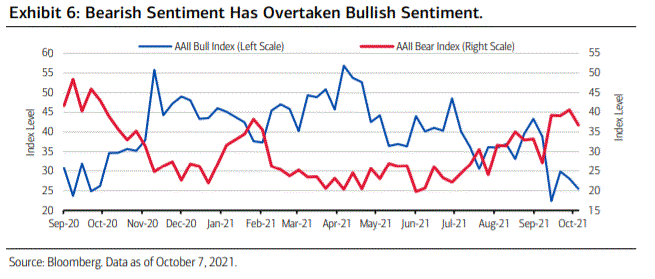Tendensen er klar. The bear har fået overtaget over the bull, hedder det i en analyse fra Merrill. Den hidtidige optisme på aktiemarkedet er svundet gevaldigt ind. En nylig meningsmåling viser, at 37 pct. i målingen viser en bjørne-attitude for de næste seks måneder, dvs. at de ser negativt på markedet efter det seneste forrygende år. Det ligger over det historiske gennemsnit på 31 pct. På samme måde er optismisternes andel, tyrene, svundet kraftigt de seneste fire uger. De ligger langt under det historiske gennemsnit på 38 pct. Merrill mener dog, at der er så meget kapital, og at virksomhederne tjener så godt, at der stadig er basis for fremgang på aktiemarkedet.
Stalling Sentiment Indicates Equity Upside
U.S. Equities are currently trading near all-time highs, with recent headwinds around political showdowns in Washington, slightly higher interest rates, credit concerns in China, and higher energy prices creating a minor pull in the S&P 500 Index. Of note is that despite a robust 17% return year-to-date for the index investor sentiment has not reached euphoric levels, with various market indicators and surveys suggesting that sentiment is in neutral territory at best, and thus remains a supporting factor for higher index levels.
According to the American Association of Individual Investors (AAII) October 6 sentiment survey, around 37% of voters expressed a bearish sentiment on the stock market for the next six months, higher than the historical average of 31%. On the other hand, bullish investor sentiment has been below its historical average of 38% for four consecutive weekly readings (Exhibit 6).

The not-so-optimistic sentiment is confirmed by the BofA Global Research Bull & Bear Indicator, where the recent reading of 5.5 continues to inch closer to bearish territory.
Our September fund manager survey also shows declining bullishness on the economy and corporate profits—only 13% of fund managers expect that the global economy will improve, and 12% expect that global profits will improve, down from 91% and 89% in
March 2021, respectively.
Market indicators tell a similar story. The Chicago Board Options Exchange (CBOE) Volatility Index (VIX), used as a gauge for investor uncertainty, remains in line with its longterm average.
And the number of S&P 500 stocks trading above their 200-day moving average has fallen to roughly 55%, down from a year-to-date high of 87% in February 20213, which could indicate room for further upside. Meanwhile, there are still record levels of cash on the sidelines—money market assets have a balance of roughly $4.5 trillion, which is almost $1 trillion more than 2019 levels, according to Bloomberg.
Fundamentals like corporate profits, stable credit markets, and accommodative monetary policy remain powerful supports for equities. A lack of euphoria among investors implies there could be further upside for stocks as the secular bull market moves forward. In our view, investors with cash on the sidelines may want to consider using a dollar-cost investing approach, especially on market weakness.

